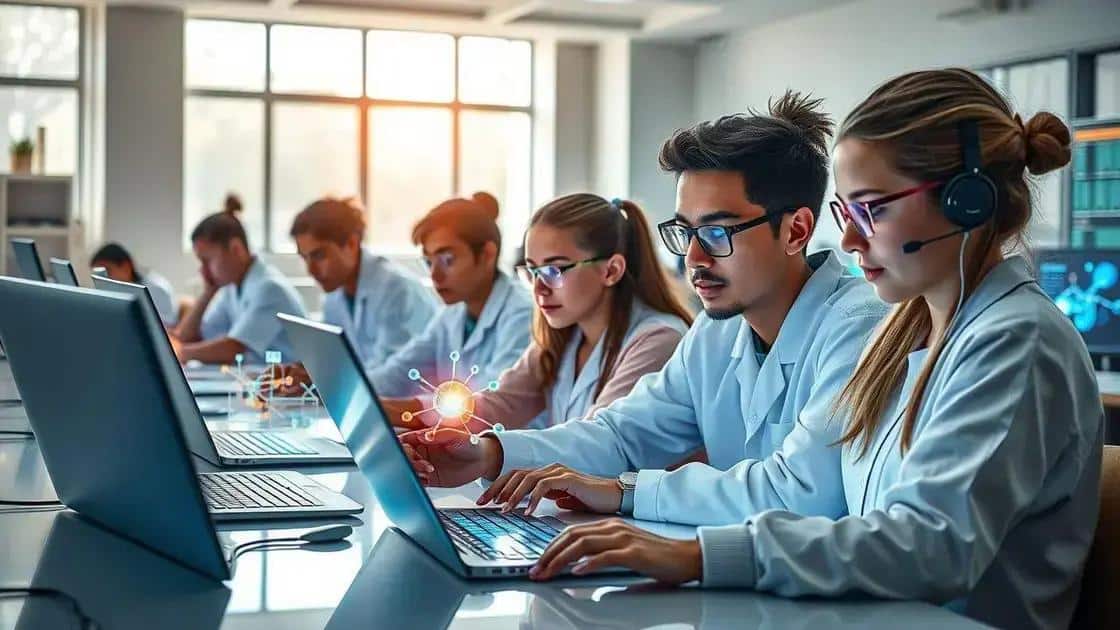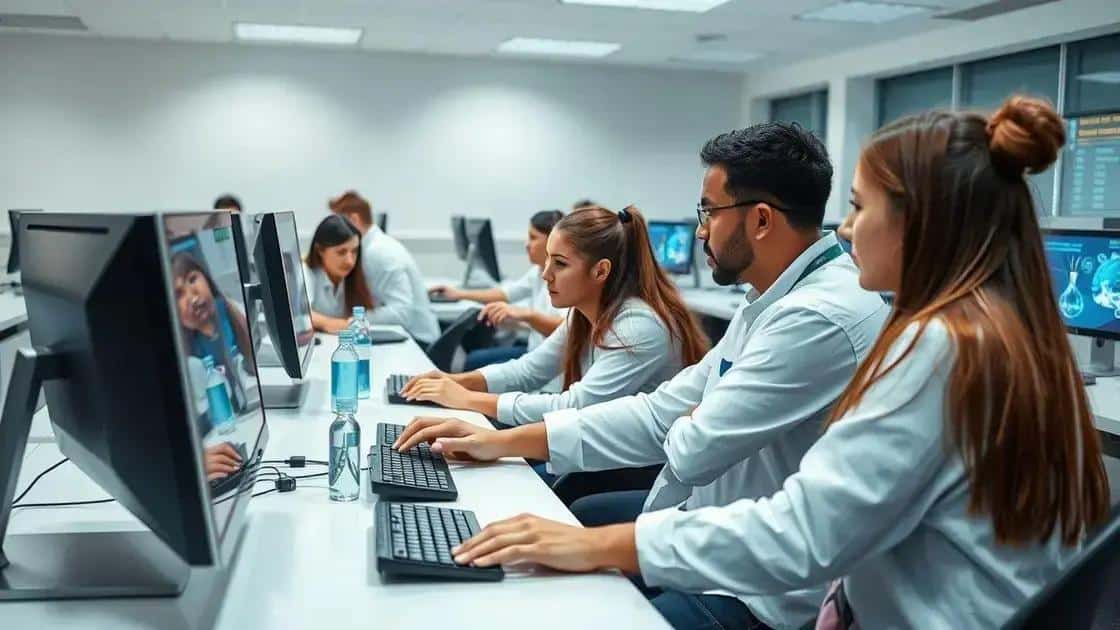Insights on virtual lab simulations: transforming education

Insights on virtual lab simulations reveal that they enhance educational experiences by providing immersive, interactive environments for students to conduct experiments safely and effectively, utilizing advanced technologies like AI and VR.
Insights on virtual lab simulations show how these digital environments are changing the way we learn. Have you ever thought about how practical experiences can be reimagined online? Let’s delve into this innovative approach to education.
Understanding virtual lab simulations
Understanding virtual lab simulations is vital in today’s educational landscape. These simulations provide a dynamic way to engage students in subjects that require hands-on experimentation. By recreating a lab environment in a virtual format, learners can explore complex concepts without the limitations of physical materials.
Virtual lab simulations allow students to experiment safely and effectively, honing their skills through interactive learning experiences.
What are virtual lab simulations?
At their core, virtual lab simulations recreate real-world lab environments in a digital format. These platforms enable students to conduct experiments, manipulate variables, and observe outcomes just as they would in a traditional lab. The flexibility of virtual labs means that students can learn at their own pace, providing an enriching educational experience.
Key features of virtual lab simulations
- Immersive graphics that mirror real-life equipment
- Interactive elements to promote active learning
- Safe environments for trial and error
- Immediate feedback to enhance understanding
These features contribute to a deeper understanding of scientific concepts. For example, a student can perform a chemistry experiment that reveals reaction rates without the risk of handling hazardous materials. This empowerment encourages learners to engage with content more meaningfully.
Moreover, virtual lab simulations offer a range of subjects, from biology to physics, making them versatile tools in education. They bridge the gap between theoretical knowledge and practical application, which is crucial for subjects requiring laboratory work.
Why choose virtual lab simulations?
The adoption of virtual lab simulations in educational institutions comes with significant advantages. They are accessible from anywhere, allowing students to revisit experiments as needed. This can enhance their mastery of complex concepts.
In addition, virtual labs reduce the logistical challenges associated with arranging physical lab resources, such as space, equipment, and safety measures. As institutions face budget constraints, these simulations can provide an effective, sustainable solution to traditional lab settings.
As technology continues to evolve, the potential for virtual lab simulations to transform the educational landscape grows, making learning more inclusive and efficient.
Benefits of virtual lab simulations in education

Benefits of virtual lab simulations in education are vast and impactful. These simulations offer students the chance to experience experiments and learn scientific concepts in a safe and controlled environment. By providing realistic scenarios, students can explore and experiment without the fear of making mistakes.
One significant advantage is accessibility. Students can engage with lab simulations from home or anywhere with an internet connection. This flexibility means that everyone can participate in hands-on learning.
Enhanced learning experiences
Through virtual lab simulations, learning becomes interactive and engaging. Students can manipulate variables and see real-time results. This hands-on approach deepens their understanding of complex subjects.
Cost-effective education
Another benefit is cost savings for schools. Traditional labs require expensive equipment and materials. With virtual labs, institutions can save on resources while providing high-quality educational experiences.
- Reduced need for physical lab space
- Lower maintenance costs for equipment
- Elimination of hazardous materials
- Access to a broader range of experiments
Furthermore, virtual labs cater to various learning styles. Visual learners benefit from interactive graphics, while kinesthetic learners engage with hands-on simulations. This inclusivity allows each student to find their preferred learning method.
Additionally, virtual lab simulations can improve student engagement. They often include gamified components, motivating students to learn and explore more deeply. The competitive aspect in some simulations encourages teamwork and collaboration among peers.
In conclusion, the benefits of virtual lab simulations not only enhance learning but also provide a comprehensive educational experience that is adaptable for diverse learners.
Key technologies powering virtual lab simulations
Key technologies powering virtual lab simulations play a crucial role in creating engaging and effective learning experiences. Understanding these technologies helps us appreciate how virtual labs function and benefit students.
One of the main technologies is virtual reality (VR). With VR, students can immerse themselves in a simulated environment that feels real. This enhances their understanding of complex concepts by allowing them to visualize processes, like chemical reactions or biological mechanisms.
Simulations and modeling tools
Another important technology is the use of simulations and modeling tools. These software applications replicate real-world scenarios, letting students interact with different variables. By changing conditions, they can see immediate outcomes, which fosters deeper learning.
- Realistic graphics that mimic actual lab equipment
- Interactive elements that allow for hands-on experimentation
- Data analysis tools for interpreting results
- Feedback mechanisms that guide student learning
Additionally, cloud computing enables easy access to these technologies. Through the cloud, students can access their labs from anywhere, making education more flexible and accommodating. This means that anyone with an internet connection can benefit from high-quality virtual labs.
Moreover, artificial intelligence enhances simulations by personalizing the learning experience. AI can adapt scenarios based on a student’s performance, providing customized challenges that suit their needs. This adaptability ensures that learners stay engaged and challenged.
As technology continues to advance, we can expect even more innovations in virtual lab simulations. With ongoing developments in machine learning and data analytics, future labs will become increasingly immersive and interactive, further enhancing educational outcomes.
Future trends in virtual lab simulations

Future trends in virtual lab simulations are exciting and full of potential. As technology evolves, these simulations will become even more integral to education. Innovations are shaping how we learn and interact with scientific concepts.
One major trend is the enhancement of artificial intelligence (AI) capabilities. AI will provide personalized learning experiences, adjusting the complexity of simulations based on a student’s performance. This tailored approach will help students grasp challenging topics more effectively.
Increased interactivity
Another trend is the push for more interactivity in simulations. Developers are working on creating more immersive environments that allow for realistic interactions. For instance, students might manipulate digital equipment that closely resembles real-life tools. This hands-on experience can deepen understanding and retention.
- Integration of augmented reality (AR) technologies
- Enhanced collaboration features for remote learning
- Use of gamification to boost engagement
- Access to real-time data for live experiments
Moreover, the integration of augmented reality (AR) will transform virtual lab simulations. With AR, students could visualize complex structures, like molecules or cells, in a three-dimensional space. This will make learning more tangible and relatable.
In addition, the future of virtual lab simulations will likely see improved accessibility features. More platforms will aim to cater to diverse learning needs, ensuring that every student can benefit from state-of-the-art education. This inclusivity will help bridge gaps in learning and provide equal opportunities.
As institutions increasingly recognize the value of virtual labs, we can expect to see more collaborations between educational organizations and tech companies. These partnerships will foster innovation and raise the quality of available simulations, making learning experiences even richer.
FAQ – Frequently Asked Questions about Virtual Lab Simulations
What are virtual lab simulations?
Virtual lab simulations are digital environments that replicate real-life lab experiences, allowing students to conduct experiments safely and interactively.
How do virtual labs enhance learning?
They provide immersive experiences, allowing students to manipulate variables and see immediate results, which helps deepen their understanding of complex concepts.
What technologies are used in virtual lab simulations?
Key technologies include virtual reality (VR), augmented reality (AR), artificial intelligence (AI), and cloud computing, which enhance interactivity and accessibility.
Are virtual lab simulations accessible for all students?
Yes, virtual labs are designed to be accessible from anywhere with an internet connection, providing flexible learning opportunities for all students.





